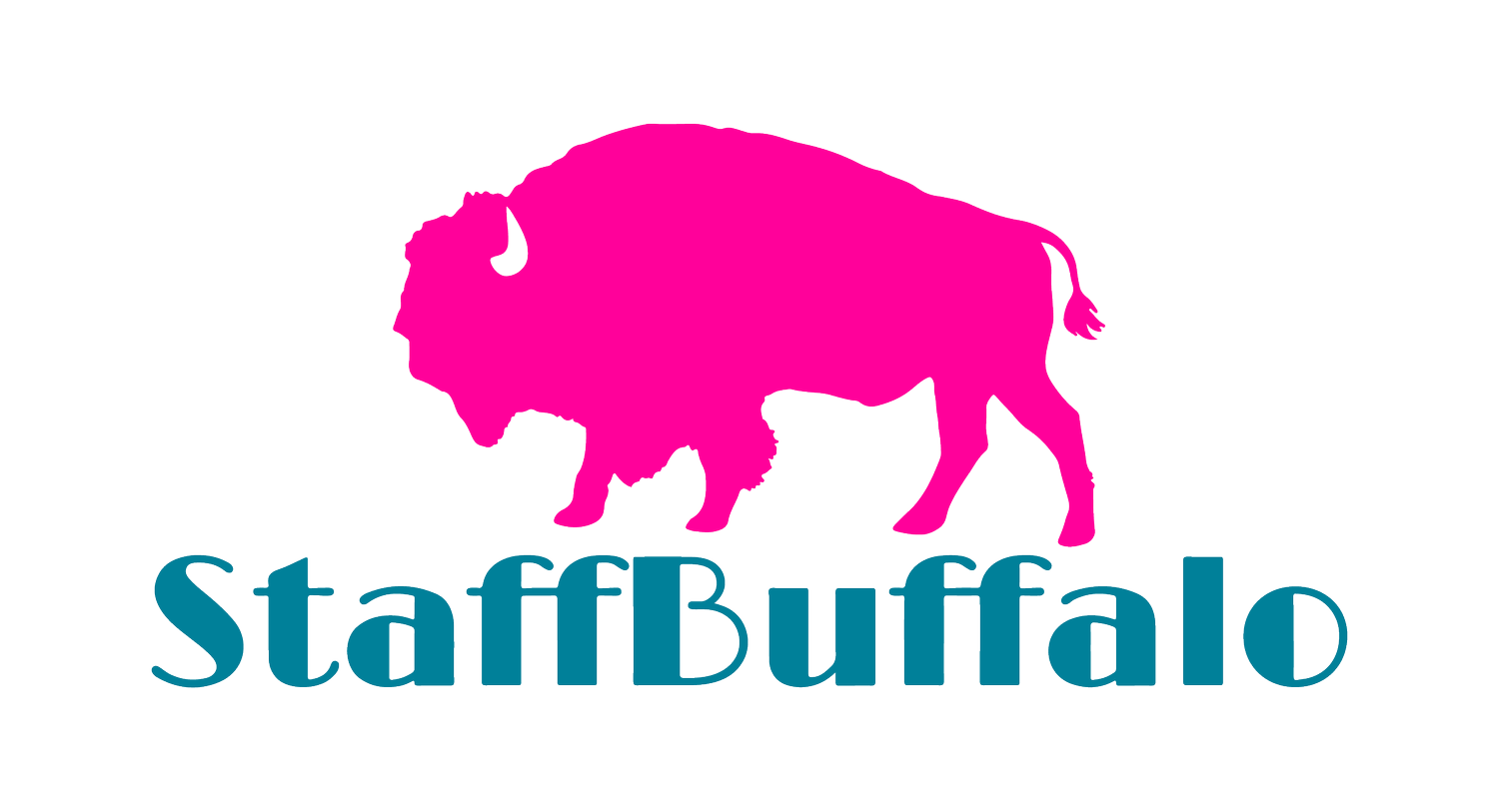StaffBuffalo's Recruiting Workshop Recap: The Pain Points of Recruiting
By: Carolyn Case, Talent Optimization Strategist
Recruiting is a bit like dating—you want to find that perfect match, but sometimes, you’re stuck swiping through candidates that don’t quite fit the bill, or worse, you find "the one" only to lose them somewhere in the process. That’s where StaffBuffalo stepped in with The Pain Points of Recruiting, a series of engaging presentations and workshops designed to help businesses break down the walls between them and their next great hire.
Held on October 8, this event was all about diving deep into the key issues companies face when recruiting: not enough applicants, too many unqualified applicants, losing candidates along the way, and—ouch—losing new hires after they’ve barely started. But we didn’t just point out the problems; we dug into the solutions, showing how companies can regain control and turn their recruiting struggles into success stories.
A Closer Look at The Candidate Experience
We kicked off the event by talking about The Candidate Experience, which is exactly what it sounds like—what candidates see, feel, and experience when they come across your company. Is your application process smooth? Are your job postings clear and inviting? Or are candidates ghosting you halfway through because things aren’t looking so great from their end?
Here’s the thing: Companies that really focus on improving their candidate experience see a massive difference. According to Glassdoor, companies that take the time to create a positive hiring experience report a whopping 70% improvement in the quality of their hires! And guess what? You’re in control of most of the factors that affect this experience. Recruiting challenges aren’t just external forces like a tight labor market—they’re also often internal and totally fixable.
Pain Point #1: Not Enough Applicants
This one’s a biggie. We’ve all been there - posting a job and hearing nothing but crickets. So, what’s going wrong?
Visibility, Visibility, Visibility: The first issue could simply be that not enough people are seeing your job posting. Remember the Rule of 7 - it takes a person seeing or hearing something seven times for it to stick. So, if you’re posting your job once or twice and hoping for the best, it’s time to crank up the volume! Post more, advertise in more places, and use social media to your advantage. Make sure you're being seen.
The Job Description Problem: Not getting enough applicants could also be because your job description is…well, underwhelming. Maybe it’s too vague, or the formatting is confusing. Worse, it might look like one of those spammy jobs floating around the internet (scams jumped 118% in 2023, according to IDTheftCenter.org). Take a hard look at your job description: Is it clear? Does it explain why working for your company is awesome? If it’s vague, fix it. If it’s dull, spice it up! You need to sell your company as much as the candidates need to sell themselves.
Your Reputation Precedes You: Job seekers are savvy. They’re checking your reviews on Glassdoor or Indeed, and if they see a bunch of unhappy former employees, they might not even consider applying. The good news? If you’ve fixed those issues, respond to the reviews! Show that you care, explain what’s changed, and invite future applicants to see the improvements for themselves. You can also encourage current employees to leave new, positive reviews.
Brand Consistency Matters: If your job posting has mismatched logos, inconsistent colors, or outdated slogans, it can give off a bad vibe. Candidates might think, "Is this company for real?" Keep your branding tight and professional to avoid looking like a potential scam.
Make It Easy: Long, clunky application processes are another reason you’re losing candidates before they even hit "submit." Did you know that 92% of job seekers abandon applications that take longer than 15 minutes (Recruiter.com)? If your process feels like a marathon, it’s time to streamline it. Use “easy apply” options wherever possible and skip the tedious, repetitive steps like manually re-entering resume details.
Pain Point #2: Too Many Unqualified Applicants
The flip side of not getting enough applicants is getting way too many—and none of them seem to have the right skills or experience. Here’s why that might be happening:
Your Job Description Isn’t Doing Its Job: If your description is too broad or unclear, you’re not helping candidates figure out if they’re a good fit. Be brutally honest about the job. Talk about the nitty-gritty. Let people know exactly what you need, and what they’re signing up for. Is your office more social and collaborative, or quiet and independent? Put it all out there so the right people apply, and the wrong ones don’t.
Sponsoring Gone Wild: When you sponsor a job post, job sites widen the net to get you more candidates—but sometimes that means casting the net too far. More doesn’t always mean better, so while sponsoring might help boost visibility, be cautious about how you use it. Quality over quantity!
Desperate Job Seekers Apply to Everything: Some candidates are just hitting "apply all" without even reading your posting. To combat this, try adding “knock-out” questions to your application process. These are questions designed to make sure the applicant meets your non-negotiable requirements, like having a specific certification or experience level. But don’t go overboard! Too many questions (or poorly written ones) can actually backfire, rejecting the right people.
During the event, attendees got hands-on by evaluating job descriptions. They found common issues like missing salary information (which is crucial for NYS postings) and inconsistencies in experience requirements. The goal? Write job descriptions that attract the right candidates from the get-go.
Pain Point #3: Losing Candidates During the Process
Now, let’s talk about losing candidates somewhere between the application and hiring stages. It’s more common than you think, and here’s why it happens:
A Disorganized Interview Process: This is a huge turnoff for candidates. If your interview process feels like a chaotic maze with no clear direction, candidates will start looking elsewhere. A smooth, well-planned process is key—72% of candidates say the interview experience impacts their final decision (Cronofy.com). Make sure everyone on your hiring team is on the same page and knows what’s expected.
Crickets from HR: Candidates hate being ghosted by employers. A lack of communication at any stage—especially after an interview—leaves them frustrated and disinterested. Set up automated responses, if necessary, but make sure to keep candidates in the loop.
How You Interview Matters: Interviews shouldn’t be interrogations. They’re a two-way conversation. Be friendly, open, and make sure the candidate feels comfortable. Let them ask questions and be prepared to “sell” your company in return.
To tackle this, we had participants create a timeline of their company’s recruiting process. By identifying bottlenecks and weak spots, they could see exactly where candidates might be getting lost or frustrated.
Pain Point #4: Losing New Hires
Finally, we tackled the heartbreaking problem of losing new hires shortly after they start. There are a few reasons this happens:
Job Descriptions Don’t Match Reality: Nearly 50% of people report that their job doesn’t match what was advertised (StackOverflow.blog). If the role or company culture is drastically different from what you promised, don’t be surprised when your new hires run for the hills.
First Day Jitters: A new hire’s first day sets the tone. If all you do is hand them paperwork, you’re missing an opportunity to make them feel welcome. Give them a proper tour, introduce them to the team, and help them feel at home.
Onboarding Is a Marathon, Not a Sprint: Onboarding should take time—ideally 3 months to a year. Many companies only offer a few weeks of training and then leave new hires to figure it out on their own. Continuous training and feedback are crucial. You want your new employees to feel supported, not abandoned.
We wrapped up with an activity where participants created the “perfect onboarding” process. They mapped out how to check in with new hires at key milestones—day 1, week 1, 30 days, 60 days, and 90 days—ensuring continuous support and feedback along the way.
Ready to Fix Your Recruiting?
In the end, The Pain Points of Recruiting was a huge success! Participants left with a fresh perspective on how to tackle their biggest recruiting challenges and actionable steps they can take to improve their hiring processes. There were lots of great conversations, new connections, and plenty of lightbulb moments.
If you’re ready to take charge of your recruiting and start attracting (and keeping) the best talent, get in touch with StaffBuffalo. Book a consultation, ask us anything, and let’s work together to make your recruitment process the best it can be. We’re here to help!





